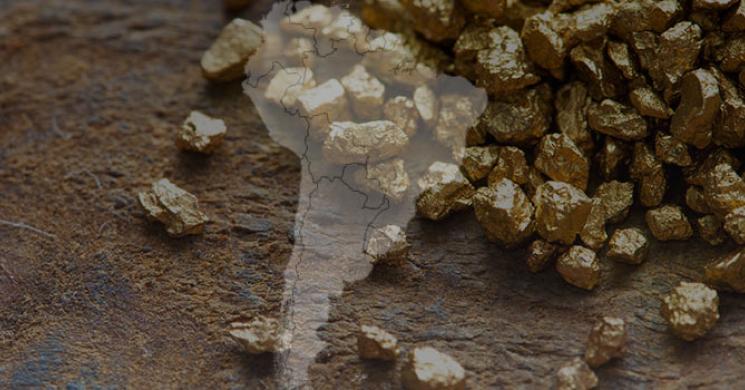
Brazil was the largest gold producing country in South America in Q1 2020. Barrick’s Veladero mine in Argentina was the largest gold operation in the region. Covid-19 shutdowns have started to take the toll on local mining industry.
Based on quarterly reported data, Mines and Metals estimated that in Q1 2020, gold production in South America amounted to 1,900 koz, a 4% decline compared to Q1 2019 (1,980 koz).
With 522 koz of gold mined during Q1 2020, Brazil was the largest gold producing country in South America. Local gold output was flat y-o-y.
Peru produced 462 koz of gold in March Quarter and has faced a 11% drop in gold output y-o-y primarily due to Covid-19 shutdowns. As a result, Peru has lost its leading South America’s gold producer status to Brazil.
Mines and Metals expects that local gold output will drop even deeper in June Quarter as the real impact of shutdowns has started to unfold later in April and May.
With 314 koz of gold produced in Q1 2020, Argentina was third largest gold producer in South America, followed by Chile (260 koz).
Covid-19 related shutdowns have started to take the toll on local mining industry which will take even bigger hit during Q2 2020.

Gold output in South America in Q1 2020, koz. Source: Mines and Metals
The following is the list of top ten largest gold mines in South America created by Mines and Metals on the basis of corporate reports.
With 150 koz of gold mined in Q1 2020, Barrick’ Veladero mine in Argentina was the largest gold producing center in South America, followed by Newmont’s Merian mine (133 koz) in Suriname and Kinross’ Paracatu mine (124 koz) in Brazil.
Fourth largest gold operation in South America was Newmont’s Yanacocha mine (122 koz) in Peru. Vale’s Salobo copper-gold mine (~83 koz) in Brazil is closing the top five list.
The detailed analysis is below.
Largest gold mines in South America. Source: Mines and Metals.

* No production data reported for Cerro Negro in Q1 2019 because of Newmont acquisition of Goldcorp. Therefore, Cerro Negro’s Q1 2020 gold output assumed the same as in 2019.
1. Veladero. 150 koz.

The Veladero mine is located in San Juan Province, Argentina, in the highly prospective Frontera District. The property is located at elevations of 4,000 to 4,850 meters above sea level, approximately 374 kilometers northwest of the city of San Juan. Veladero is a 50/50 joint venture operation with Shandong Gold. In 2007, Barrick Gold installed the world’s highest-altitude wind turbine at the Veladero mine at nearly 4,200m elevation.
2. Merian. 133 koz.

The Merian gold mine is located approximately 60 km south of Moengo, Suriname. Newmont Suriname (previously known as Suriname Gold Company) is a fully-owned subsidiary of Newmont that is operated on behalf of Suriname Gold Project CV, a Suriname limited partnership. Construction of Merian commenced in August 2014, and commercial production was achieved on October 1, 2016, on schedule and US$150 million under budget.
3. Paracatu. 124 koz.

Kinross’ Paracatu gold mine is located in Brazil, north of Paracatu city and nearly 230km from the capital city of Brazil, Brasília. Paracatu is the largest gold mine in South America and one of the largest in the world. Paracatu had an outstanding year in 2019, achieving record annual production of 619,563 Au while lowering costs. The strong performance was mainly due to an asset optimization program started in 2018, which resulted in improved mill efficiencies and an enhanced understanding of the orebody.
4. Yanacocha. 122 koz.

Yanacocha gold mine is located in the province and department of Cajamarca, approximately 800 kilometers northeast of Lima, Peru. Yanacocha’s operations are situated between 3,500 and 4,100 meters above sea level with development activities in four primary basins. The operation is a joint venture between Newmont (51.35%), Minas Buenaventura (43.65%) and the International Finance Corporation (5%). The mine poured its first gold ore bar on August 7, 1993.
5. Salobo. 83 koz.

Vale’s Salobo mine is the largest copper deposit ever discovered in Brazil and important source of gold, too. The low-cost copper-gold mine began operating in May 2012 with a design throughput capacity of 12 million tonnes per annum. Vale has subsequently completed a second phase of construction to expand the mine to 24 Mtpa of mill capacity. Salobo is an integrated operation of open pit mining, mineral processing beneficiation, concentrate loading and transportation. The copper concentrate is transported by road from the mine to Vale’s existing rail terminal in Parauapebas, from where it is carried by the Carajás railroad to the Ponta da Madeira maritime terminal located in Sao Luis.
Read more by Vladimir Basov







